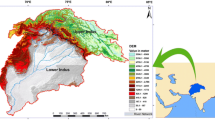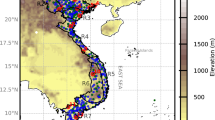Abstract
A new bias-corrected statistically downscaled product, namely, the NASA Earth Exchange Global Daily Downscaled Projections (NEX-GDDP), has recently been developed by NASA to help the scientific community in climate change impact studies at local to regional scale. In this work, the product is validated over India and its added value as compared to its CMIP5 counterpart for the NCAR CCSM4 model is analyzed, followed by climate change projections under the RCP8.5 global warming scenario using the two datasets for the variables daily maximum 2-m air temperature (Tmax), daily minimum 2-m air temperature (Tmin), and rainfall. It is found that, overall, the CCSM4-NEX-GDDP significantly reduces many of the biases in CCSM4-CMIP5 for the historical simulations; however, some biases such as the significant overestimation in the frequency of occurrence in the lower tail of the Tmax and Tmin still remain. In regard to rainfall, an important value addition in CCSM4-NEX-GDDP is the alleviation of the significant underestimation of rainfall extremes found in CCSM4-CMIP5. The projected Tmax from CCSM4-NEX-GDDP are in general higher than that projected by CCSM4-CMIP5, suggesting that the risks of heat waves and very hot days could be higher than that projected by the latter. CCSM4-NEX-GDDP projects the frequency of occurrence of the upper extreme values of historical Tmax to increase by a factor of 100 towards the end of century (as opposed to a factor of 10 increase projected by CCSM4-CMIP5). In regard to rainfall, both CCSM4-CMIP5 and CCSM4-NEX-GDDP project an increase in annual rainfall over India under the RCP8.5 global warming scenario progressively from the near term through the far term. However, CCSM4-NEX-GDDP consistently projects a higher magnitude of increase and over a larger area as compared to that projected by CCSM4-CMIP5. Projected daily rainfall distributions from CCSM4-CMIP5 and CCSM4-NEX-GDDP suggest the occurrence of events that have no historical precedents. Worth noting is that the extreme daily rainfall values projected by CCSM4-NEX-GDDP are two to three times larger than that projected by CCSM4-CMIP5.









Similar content being viewed by others
References
Ahmadalipour A, Moradkhani H, Svoboda M (2017) Centennial drought outlook over the CONUS using NASA-NEX downscaled climate ensemble. Int J Climatol 37:2477–2491. https://doi.org/10.1002/joc.4859
Chaturvedi RK, Joshi J, Jayaraman M, Bala G, avindranath NHR (2012) Multi-model climate change projections for India under representative concentration pathways. Curr Sci 103(7):791–802
Chen J, Brissette FP, Chaumont D, Braun M (2013) Finding appropriate bias correction methods in downscaling precipitation for hydrologic impact studies over North America. Water Resour Res 49:4187–4205. https://doi.org/10.1002/wrcr.20331
Knutti R, Masson D, Gettelman A (2013) Climate model genealogy: generation CMIP5 and how we got there. Geophys Res Lett 40:1194–1199. https://doi.org/10.1002/grl.50256
Maurer EP, Hidalgo HG (2008) Utility of daily vs. monthly large-scale climate data: an intercomparison of two statistical downscaling methods. Hydrol Earth Syst Sci 12:551–563
Mishra SK, Sahany S, Salunke P (2017) CMIP5 vs. CORDEX over the Indian region: how much do we benefit from dynamical downscaling? Theor Appl Climatol. https://doi.org/10.1007/s00704-017-2237-z
Pai DS, Sridhar L, Rajeevan M, Sreejith OP, Satbhai NS, Mukhopadhyay B (2014) Development of high spatial resolution (0.25° × 0.25°) long period (1901–2010) daily gridded rainfall data set over India and its comparison with existing data sets over the region. Mausam 65:1–18
Sabeerali CT, Rao SA, Dhakate AR, Salunke K, Goswami BN (2015) Why ensemble mean projection of south Asian monsoon rainfall by CMIP5 models is not reliable? Clim Dyn 45(16):1–174. https://doi.org/10.1007/s00382-014-2269-3
Saha A, Ghosh S, Sahana AS, Rao EP (2014) Failure of CMIP5 climate models in simulating post-1950 decreasing trend of Indian monsoon. Geophys Res Lett 41(20):7323–7330
Salvi K, Kannan S, Ghosh S (2011) Statistical downscaling and bias correction for projections of Indian rainfall and temperature in climate change studies, in 2011 International Conference on Environmental and Computer Science, vol. 19, IACSIT Press, Singapore, pp 7–11
Sheffield J, Goteti G, Wood EF (2006) Development of a 50-yr high-resolution global dataset of meteorological forcings for land surface modeling. J Clim 19(13):3088–3111
Sooraj KP, Terray P, Mujumdar M (2015) Global warming and the weakening of the Asian summer monsoon circulation: assessments from the CMIP5 models. Clim Dyn 45(1–2):233–252
Srivastava AK, Rajeevan M, Kshirsagar SR (2009) Development of a high resolution daily gridded temperature data set (1969–2005) for the Indian region. Atmos Sci Lett 10:249–254. https://doi.org/10.1002/asl.232
Taylor KE, Stouffer RJ, Meehl GA (2012) An overview of CMIP5 and the experiment design. Bull Am Meteorol Soc 93:485–498
Themeßl MJ, Gobiet A, Heinrich G (2011) Empirical-statistical downscaling and error correction of regional climate models and its impact on the climate change signal. Clim Chang 112:449–468. https://doi.org/10.1007/s10584-011-0224-4
Thrasher B, Maurer EP, McKellar C, Duffy PB (2012) Technical note: bias correcting climate model simulated daily temperature extremes with quantile mapping. Hydrol Earth Syst Sci 16(9):3309–3314
Wood AW, Maurer EP, Kumar A, Lettenmaier DP (2002) Long-range experimental hydrologic forecasting for the eastern United States. J Geophys Res Atmospheres 107:4429. https://doi.org/10.1029/2001JD000659
Wood AW, Leung LR, Sridhar V, Lettenmaier DP (2004) Hydrologic implications of dynamical and statistical approaches to downscaling climate model outputs. Clim Chang 15:189–216
Acknowledgments
The authors sincerely thank the anonymous reviewer and the editor for the helpful suggestions that have significantly helped in improving the paper. The DST Centre of Excellence in Climate Modeling at IIT Delhi, and the Science and Engineering Research Board (for research grant ECR/2015/000229) are thankfully acknowledged for support. The use of the CMIP5 outputs and IMD dataset are thankfully acknowledged. We thankfully acknowledge the use of the NEX-GDDP dataset prepared by the Climate Analytics Group and NASA Ames Research Center using the NASA Earth Exchange, and distributed by the NASA Center for Climate Simulation (NCCS).
Author information
Authors and Affiliations
Corresponding author
Rights and permissions
About this article
Cite this article
Sahany, S., Mishra, S.K. & Salunke, P. Historical simulations and climate change projections over India by NCAR CCSM4: CMIP5 vs. NEX-GDDP. Theor Appl Climatol 135, 1423–1433 (2019). https://doi.org/10.1007/s00704-018-2455-z
Received:
Accepted:
Published:
Issue Date:
DOI: https://doi.org/10.1007/s00704-018-2455-z




